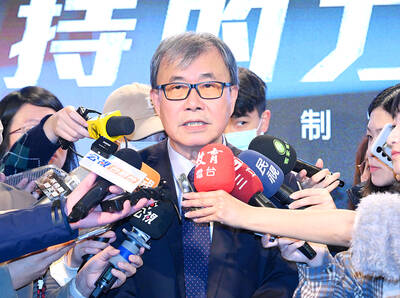South Korean President Lee Myung-bak called for calm yesterday as the won suffered its biggest daily loss for a decade, saying the nation need not fear a repeat of the 1997 to 1998 Asian Financial Crisis.
The current situation “is wholly different from the foreign exchange crisis of 1997,” he told a Cabinet meeting.
“Excessive optimism is dangerous but we don’t have to be mired in pessimism and a sense of crisis,” he said.
The local currency closed at 1,328.1 to the dollar, down 59.1 won from Monday’s close and the lowest level since April 12, 2002. The daily loss was the biggest since August 1998 when it fell by 70 won.
The currency has fallen 29 percent against the dollar so far this year, fuelling already high inflation.
“The won’s steep fall came as market participants panicked on concerns that financial market turmoil which started in the United States is spreading into Europe and other countries,” Jeon Seung-ji, an analyst at Samsung Futures, told Yonhap news agency.
The won plunged to 1,350 at one point but clawed back on dollar-selling by the authorities.
The forex market is suffering from a dollar shortage as banks and companies rush to the greenback on concerns of a global financial crisis.
The KOSPI benchmark stock index closed 0.5 percent higher on bargain-hunting by local funds.
“The government is now striving to expand its foreign exchange holdings and liquidity, while the corporate sector is making its own restructuring effort,” Lee said. “Above all, the most important thing is for the government to give confidence to the people.”
Lee and other top financial officials agreed that concerns over the risks posed by the possible redemption of the nation’s offshore debt are overdone, Deputy Finance Minister for Foreign Affairs Shin Je-yoon said.
“We admit that conditions are difficult, but considering the nature of the offshore debt, we can certainly handle the burden,” Shin said.
The meeting also decided to investigate whether markets have been manipulated.
“The trading volume is very thin these days, but [the dollar and won are] fluctuating heavily,” Shin said. “We smell something and we think it’s necessary to analyze.”
He said supply and demand will likely improve markedly once the current account swings to surplus. Authorities have spent almost US$25 billion since March trying to support the won, Yonhap reported.
The spending has cut foreign reserves to US$239.7 billion, still the world’s sixth-largest.

STILL COMMITTED: The US opposes any forced change to the ‘status quo’ in the Strait, but also does not seek conflict, US Secretary of State Marco Rubio said US President Donald Trump’s administration released US$5.3 billion in previously frozen foreign aid, including US$870 million in security exemptions for programs in Taiwan, a list of exemptions reviewed by Reuters showed. Trump ordered a 90-day pause on foreign aid shortly after taking office on Jan. 20, halting funding for everything from programs that fight starvation and deadly diseases to providing shelters for millions of displaced people across the globe. US Secretary of State Marco Rubio, who has said that all foreign assistance must align with Trump’s “America First” priorities, issued waivers late last month on military aid to Israel and Egypt, the

‘UNITED FRONT’ FRONTS: Barring contact with Huaqiao and Jinan universities is needed to stop China targeting Taiwanese students, the education minister said Taiwan has blacklisted two Chinese universities from conducting academic exchange programs in the nation after reports that the institutes are arms of Beijing’s United Front Work Department, Minister of Education Cheng Ying-yao (鄭英耀) said in an exclusive interview with the Chinese-language Liberty Times (the Taipei Times’ sister paper) published yesterday. China’s Huaqiao University in Xiamen and Quanzhou, as well as Jinan University in Guangzhou, which have 600 and 1,500 Taiwanese on their rolls respectively, are under direct control of the Chinese government’s political warfare branch, Cheng said, citing reports by national security officials. A comprehensive ban on Taiwanese institutions collaborating or

France’s nuclear-powered aircraft carrier and accompanying warships were in the Philippines yesterday after holding combat drills with Philippine forces in the disputed South China Sea in a show of firepower that would likely antagonize China. The Charles de Gaulle on Friday docked at Subic Bay, a former US naval base northwest of Manila, for a break after more than two months of deployment in the Indo-Pacific region. The French carrier engaged with security allies for contingency readiness and to promote regional security, including with Philippine forces, navy ships and fighter jets. They held anti-submarine warfare drills and aerial combat training on Friday in

COMBAT READINESS: The military is reviewing weaponry, personnel resources, and mobilization and recovery forces to adjust defense strategies, the defense minister said The military has released a photograph of Minister of National Defense Wellington Koo (顧立雄) appearing to sit beside a US general during the annual Han Kuang military exercises on Friday last week in a historic first. In the photo, Koo, who was presiding over the drills with high-level officers, appears to be sitting next to US Marine Corps Major General Jay Bargeron, the director of strategic planning and policy of the US Indo-Pacific Command, although only Bargeron’s name tag is visible in the seat as “J5 Maj General.” It is the first time the military has released a photo of an active